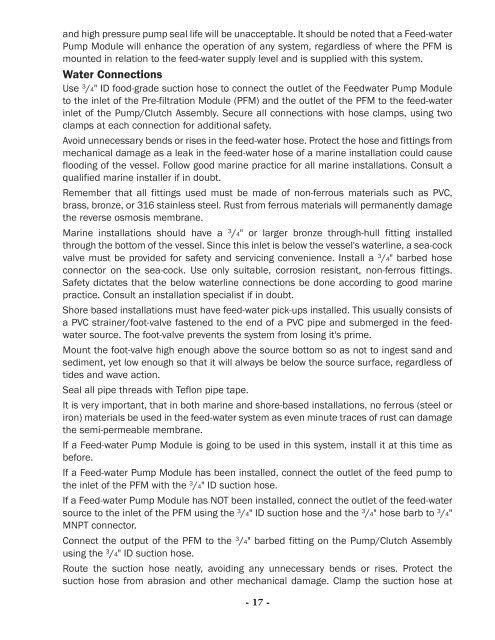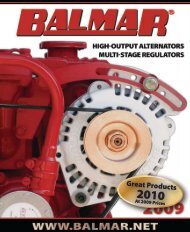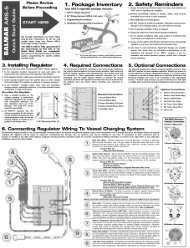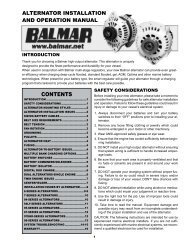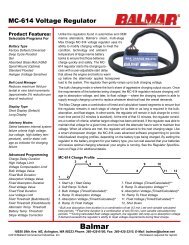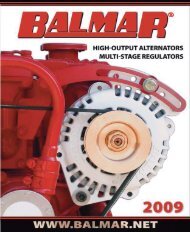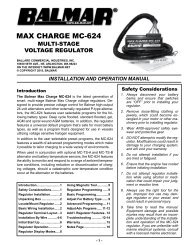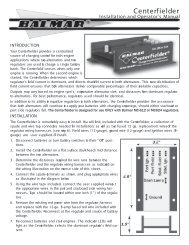You also want an ePaper? Increase the reach of your titles
YUMPU automatically turns print PDFs into web optimized ePapers that Google loves.
and high pressure pump seal life will be unacceptable. It should be noted that a Feed-waterPump Module will enhance the operation of any system, regardless of where the PFM ismounted in relation to the feed-water supply level and is supplied with this system.Water ConnectionsUse 3 /4" ID food-grade suction hose to connect the outlet of the Feedwater Pump Moduleto the inlet of the Pre-filtration Module (PFM) and the outlet of the PFM to the feed-waterinlet of the Pump/Clutch Assembly. Secure all connections with hose clamps, using twoclamps at each connection for additional safety.Avoid unnecessary bends or rises in the feed-water hose. Protect the hose and fittings frommechanical damage as a leak in the feed-water hose of a marine installation could causeflooding of the vessel. Follow good marine practice for all marine installations. Consult aqualified marine installer if in doubt.Remember that all fittings used must be made of non-ferrous materials such as PVC,brass, bronze, or 316 stainless steel. Rust from ferrous materials will permanently damagethe reverse osmosis membrane.Marine installations should have a 3 /4" or larger bronze through-hull fitting installedthrough the bottom of the vessel. Since this inlet is below the vessel's waterline, a sea-cockvalve must be provided for safety and servicing convenience. Install a 3 /4" barbed hoseconnector on the sea-cock. Use only suitable, corrosion resistant, non-ferrous fittings.Safety dictates that the below waterline connections be done according to good marinepractice. Consult an installation specialist if in doubt.Shore based installations must have feed-water pick-ups installed. This usually consists ofa PVC strainer/foot-valve fastened to the end of a PVC pipe and submerged in the feedwatersource. The foot-valve prevents the system from losing it's prime.Mount the foot-valve high enough above the source bottom so as not to ingest sand andsediment, yet low enough so that it will always be below the source surface, regardless oftides and wave action.Seal all pipe threads with Teflon pipe tape.It is very important, that in both marine and shore-based installations, no ferrous (steel oriron) materials be used in the feed-water system as even minute traces of rust can damagethe semi-permeable membrane.If a Feed-water Pump Module is going to be used in this system, install it at this time asbefore.If a Feed-water Pump Module has been installed, connect the outlet of the feed pump tothe inlet of the PFM with the 3 /4" ID suction hose.If a Feed-water Pump Module has NOT been installed, connect the outlet of the feed-watersource to the inlet of the PFM using the 3 /4" ID suction hose and the 3 /4" hose barb to 3 /4"MNPT connector.Connect the output of the PFM to the 3 /4" barbed fitting on the Pump/Clutch Assemblyusing the 3 /4" ID suction hose.Route the suction hose neatly, avoiding any unnecessary bends or rises. Protect thesuction hose from abrasion and other mechanical damage. Clamp the suction hose at- 17 -


